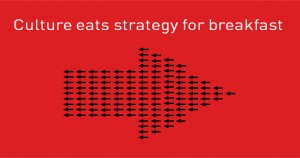Culture Eats Strategy for Breakfast
 A new CEO sweeps into your company and announces a new strategy. Your company hasn’t been doing too well so you think it just might be time for a new strategy — the old one wasn’t working, maybe a new one will. Unfortunately, the new strategy doesn’t fit well with your existing culture, which focuses on quality. The new CEO wants to focus on speed — “Let’s get to market before our competitors do — the first mover has the advantage”. Yet your fellow employees think, “There’s always a market for quality. Quality wins in the long run.”
A new CEO sweeps into your company and announces a new strategy. Your company hasn’t been doing too well so you think it just might be time for a new strategy — the old one wasn’t working, maybe a new one will. Unfortunately, the new strategy doesn’t fit well with your existing culture, which focuses on quality. The new CEO wants to focus on speed — “Let’s get to market before our competitors do — the first mover has the advantage”. Yet your fellow employees think, “There’s always a market for quality. Quality wins in the long run.”
When strategy and culture are at odds with each other, which one wins? Culture wins every time. In fact, Peter Drucker said that “culture eats strategy for breakfast.” Changing strategy is fairly easy — it’s just an announcement. But if the new strategy doesn’t fit the culture, it’s simply an announcement of prospective failure. First, you have to change the culture.
Watch the video for more information on culture versus strategy.
Strategy versus Operational Effectiveness
As the cheshire cat once said, “if you don’t know where you’re going then any road will lead you there.” It’s certainly true of strategy. When I ask companies what their strategy is, they often say things like, “we’re going to reduce our supply chain costs.” While that’s a  good thing to do, it’s not a strategy — it’s operations. Reducing supply chain costs is improving operational effectiveness, not refining your strategy.
good thing to do, it’s not a strategy — it’s operations. Reducing supply chain costs is improving operational effectiveness, not refining your strategy.
To refine your strategy, it’s useful to ask yourself a simple question: “… and where will that lead us?” We’re going to reduce our supply chain costs … and where will that lead us? That will lower our costs … and where will that lead us? That will help us appeal to price sensitive customers … and where will that lead us? Keep asking the same question repeatedly until you reach a logical conclusion. That’s likely to be your strategy.
(Other useful questions to ask are: “…and who would be interested in that?” and “… and why would they buy from us?”. Or simply: “So what?”).
According to Michael Porter, there are really only three strategies that you can pursue. Learn about them in the video.
Breathing and Profits
 People often assume that making a profit is the purpose of business. But is it really? There are many different ways to judge success. Long-term success ultimately comes from your customers’ response to your offer. If you make your customers better in some way — happier, stronger, healthier, etc. — you’ll probably be successful. If you don’t, you won’t. It’s like breathing. Find out more in the video.
People often assume that making a profit is the purpose of business. But is it really? There are many different ways to judge success. Long-term success ultimately comes from your customers’ response to your offer. If you make your customers better in some way — happier, stronger, healthier, etc. — you’ll probably be successful. If you don’t, you won’t. It’s like breathing. Find out more in the video.
How much is a brand worth?
Quick — what’s the most valuable brand in the world? Interbrand says it’s Coca-Cola, valued at $71.8 billion. Eurobrands say it’s Apple, valued at $96.6 billion. And Brand Finance says it’s Google, valued at $44.3 billion. Interbrand, Eurobrands, and Brand Finance are the three most prominent brand evaluation companies in the world. They all use the same ISO standard for calculating the value of a brand. Yet, they wind up with wildly divergent views on brand value. Why is that? It’s because brand value is in the eye of the beholder and that is completely subjective.
Building Brands Consistently
Who’s Grover White? If you don’t know him, you really should meet him. He’s a great guy. But because we’ve changed his name — ever so slightly — we may have confused you. Grover is better known under a different brand name … but you would never know that if we haven’t used the brand name consistently.
Great brands deploy their names and symbols consistently. You know who they are because they never change what they call themselves. They minimize confusion and, by doing so, they maximize trust. And a brand is simply a name that you trust.
To find out who Grover White is, just watch the video.